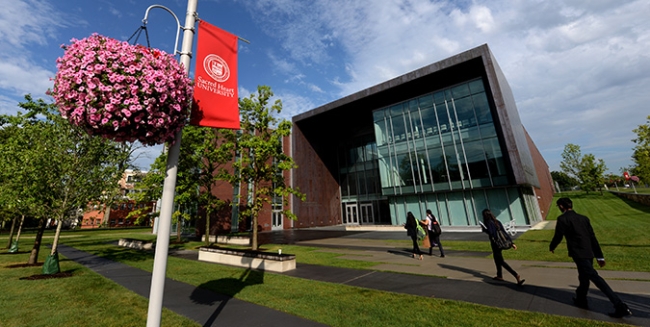You have /5 articles left.
Sign up for a free account or log in.

Sacred Heart University has reached a deal that could have it acquiring St. Vincent's College in Connecticut next year.
Sacred Heart University
A pair of Roman Catholic institutions continued a national trend toward private college consolidations Friday, with a large university in Connecticut striking a deal that will likely have it acquiring a nearby nursing college next year.
Sacred Heart University, an 8,500-student university with its main campus in Fairfield, Conn., is entering a management agreement with St. Vincent’s College. St. Vincent’s, which mostly awards two-year degrees in nursing, is a much smaller college located about three miles away at St. Vincent’s Medical Center.
The deal is structured as a management agreement that will at first have St. Vincent’s paying Sacred Heart for assistance in areas like staffing, admissions, financial aid, student affairs and information technology. The two institutions will also work to gain accreditor and state approval for an acquisition that would make St. Vincent’s a part of Sacred Heart. If approved, that acquisition would likely take place in about a year.
Leaders at the two institutions say the agreement gives students access to clinical opportunities, makes transfers easier and takes financial pressures off St. Vincent’s. Students at Sacred Heart University, which already has colleges of nursing and health professions among its five divisions, will have more access to inpatient clinical sites, they said. St. Vincent’s students, meanwhile, will have routes to pursue bachelor’s and master’s degrees at Sacred Heart.
There are no plans to move programs out of St. Vincent’s Medical Center, said Michael Gargano, president of St. Vincent’s College, which is a subsidiary of the 473-bed hospital. It is primarily located in the hospital and medical center complex, although it also has a location about a block away that houses a radiology program.
The new management agreement will give St. Vincent’s College access to scale it needs to provide services students and faculty members need, Gargano said.
“I think, quite honestly, what you’re seeing is something that is probably going to transpire throughout higher education in the coming years,” Gargano said. “A lot of times with these small, niche institutions, they just don’t have the financial wherewithal to support all aspects of the operation.”
St. Vincent’s enrolls a large number of low-income students. Almost 30 percent of its students are eligible for federal Pell Grants, which indicates they come from families with low incomes.
Most students attend part time, and many transfer in from a community college, Gargano said. Another large portion of the college’s student body is returning to college to start a second career.
St. Vincent’s operates on a much smaller scale than Sacred Heart. St. Vincent’s has spent about $10 million annually in recent years, according to tax documents filed with the federal government. It has 22 full-time faculty members and another 30 or 40 adjuncts, Gargano said. Sacred Heart, on the other hand, spends well over $200 million annually while employing 840 full-time and 665 part-time faculty members and staff. Sacred Heart’s College of Nursing has 828 undergraduates between its campus and online programs -- more than St. Vincent’s entire enrollment. Sacred Heart also has 793 graduate students in its College of Nursing.
St. Vincent’s currently has associate degree programs in nursing, radiography and general studies. It also offers online bachelor’s degree completion programs in nursing, radiological sciences and health-care administration, along with certificate programs in health-care fields. Sacred Heart University has more than 70 programs on its main campus.
The deal between the institutions comes shortly after speculation over whether St. Vincent’s Medical Center was up for sale or merger. The hospital, founded in 1903, is a part of Ascension Health, a large national Catholic health system. Officials confirmed to the Connecticut Post at the end of February that options for the hospital were under consideration. But then at the beginning of March, they said no deal was pending.
It also comes as many private colleges and universities around the country are exploring mergers. Trevecca Nazarene University, in Nashville, Tenn., and Eastern Nazarene University, outside Boston, are weighing a merger under an agreement reached in March. Barry University and St. Thomas University, two Roman Catholic institutions in the Miami area, are looking into a strategic alliance.
The situation is no different in Connecticut, said Jennifer Widness, president of the Connecticut Conference of Independent Colleges.
“Smaller private institutions are highly tuition dependent,” she said. “It’s expensive to run a college.”
Other private institutions in Connecticut are considering changes as well. For instance, the University of St. Joseph, which has traditionally limited its undergraduate offerings to women, said in November it would study whether it should admit men.
In Connecticut, private colleges and universities have an added pressure that comes from a drop in state-based aid offerings. A need-based program that was recently renamed -- from the Governor’s Scholarship Program to the Roberta B. Willis Scholarship program -- has been cut significantly, Widness said.
“That’s another issue we have in Connecticut,” she said.




